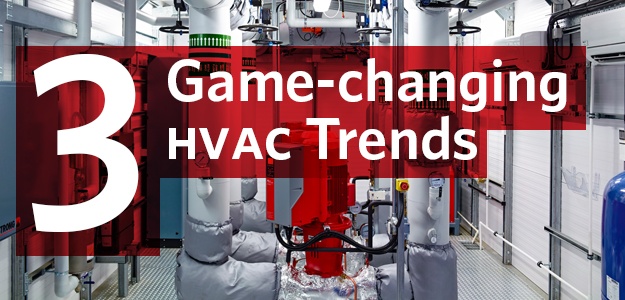
With approximately 40% of energy costs attributed to HVAC use in commercial buildings, property owners are increasingly turning to retrofit solutions that will help them operate their systems more efficiently. New advancements in wireless communication and embedded intelligence can significantly lower operational and maintenance costs. Here are three HVAC trends in 2017 that are making a splash in the industry.
1) Connectivity with Embedded Intelligence
The engineering community is refining HVAC design to run equipment in parallel at part loads. To achieve this parallel scheduling, however, equipment needs to communicate amongst itself and intelligence is needed to initiate the sequence. Embedded connectivity facilitates these operational decisions. With proper synchronization, energy savings of up to 70% can be achieved. And with wireless communication, units don’t have to be physically hardwired together so installers aren’t constrained by space limitations.
Wireless sensors can also relay performance data for users to analyze. For example, most HVAC maintenance is performed on a predetermined schedule whether a unit requires attention or not. With integrated intelligence, however, sensors can generate a signal when troubleshooting or maintenance is needed. Predictive analytics help building owners avoid redundant upkeep costs and minimize downtime due to unexpected repairs.
2) Savings with Wireless Data
Intelligent sensors provide operational insights that are otherwise hard to capture. For example, differential pressure sensors degrade over time and become unreliable and difficult to maintain. If pumps have been pre-programmed to calculate this value (differential pressure), a separate sensor is no longer necessary. Armstrong pre-maps its pumps based on factory tested performance. Based on this performance map, differential pressure is calculated in the field as other conditions change and flow is modulated to meet the requirements of the system. Not only are there savings from reduced installation costs (no sensor and associated labor to install), but the end user benefits from more accurate data rather than relying on uncalibrated sensors.
2017 will also see an acceleration in installed devices that connect over Wi-Fi and Bluetooth so data can be retrieved on handheld devices. Plus, there is a new wave of HVAC apps that assist with service, purchasing, and delivery tracking.
With wireless communication, security is a concern, but connectivity doesn’t have to be over the internet. Wireless sensors can be configured as an internal network – a private Internet of Things. Ask manufacturers about their data-encryption standards, as well as what options they provide to disable devices.
3) Upgrade with Retrofit Options
With the success of consumer apps for everything from banking to driving directions, property managers now expect similar levels of connectivity within building systems. We anticipate a big revolution in the next five years where facilities will be extensively retrofitted with smart technology. New units have had some degree of embedded intelligence for a number of years, but there is a growing number of replacement options that makes it easy to capture additional savings. For example, a building owner who is upgrading to variable speed options can specify retrofit equipment that includes connectivity. This added functionality ensures they can capture both performance and lifecycle savings.
Armstrong is proud to announce our new Design Envelope pumps that deliver context and insight in real-time. This suite of intelligent pumps optimizes lifetime HVAC performance through actionable data. Newly added iECM™ technology delivers IE4 levels of efficiency and the new Armstrong interface provides onboard trending and diagnostics, WiFi connectivity and enhanced control functions. To learn more about how these solutions will enhance your HVAC efficiency, click here to visit the product page.
Also seen in:
- empoweringpumps.com – June 15, 2017



